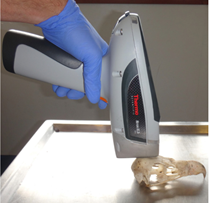Environmental Research
The Game Management Authority conducts the following environmental research.
The University of Melbourne, RMIT, Murdoch University and the GMA have collaborated on research into the prevalence of lead concentrations in Victorian waterbirds. This study estimated lead exposure via measuring bone lead concentrations in the Pacific black duck (Anas superciliosa).
Lead shot has been banned for all waterfowl hunting in Victoria since 2002. This research is the first assessment of lead exposure in Australian waterfowl to be published since the 1990s.
The humerus bone from wings of 77 Pacific black ducks harvested by hunters in 2018 and 2021, from nine waterfowl hunting sites, were analysed using portable X-ray fluorescence (XRF). This method was then validated using inductively coupled plasma mass spectrometry (ICP-MS).
Greater than 92% of ducks sampled had only background lead exposure (<10 mg/kg). When compared to historical studies in the same species at similar field sites from the 1990s, lead exposure levels were considerably lower, with mean lead concentrations approximately two-fold lower (3.7 c.f. 7.7 mg/kg), and the frequency of birds with severe lead exposure (>20 mg/kg) approximately three-fold lower (2.6 c.f. 7.5 %).
The results confirm that portable XRF is a useful option for measurement of bone lead in Australasian waterbird species. The findings also show that the ban on the use of lead shot in Victoria (approx. 20 years ago) has substantially reduced lead exposure in the Pacific black duck.
See Expanding the use of portable XRF to monitor lead exposure in an Australian duck species two decades after a ban on lead shot for a copy of the research paper.
 Researchers from the University of Melbourne with financial support from the GMA studied two different methods of lead detection in animals to determine if one method was more accurate than the other. The more commonly used plasma mass spectrometry scanning machine was compared with the new portable handheld X-ray device. The study also provided the opportunity to examine bone lead levels in wedge-tailed eagles (Aquila audax) from east Gippsland and Tasmania.
Researchers from the University of Melbourne with financial support from the GMA studied two different methods of lead detection in animals to determine if one method was more accurate than the other. The more commonly used plasma mass spectrometry scanning machine was compared with the new portable handheld X-ray device. The study also provided the opportunity to examine bone lead levels in wedge-tailed eagles (Aquila audax) from east Gippsland and Tasmania.
Results showed that both methods of lead detection produced similar results, suggesting that the new portable X-ray device could be a useful and inexpensive option that is less destructive to the analysed specimens.
The study also found that over 50 per cent of the eagles examined had elevated lead levels (>10 mg/kg) and 13 per cent had severe lead exposure (>20 mg/kg).
The severe level of exposure to lead found in 13 percent of Victorian wedge-tailed eagles was found in just one per cent of Tasmanian wedge-tailed eagles. This difference may be explained by the hunting and animal management practices that occur in the area.
South-eastern mainland Australia is likely to be one of the highest risk places in Australia for exposure to lead from ammunition, with year-round recreational deer hunting, culling of kangaroos and unregulated culling of pest species. Aerial shooting has been increasingly used to control deer in south-eastern Australia and may represent a significant source of ingestible lead to scavenging wildlife. This study suggests that continued research into the impacts of lead-based ammunition on native wildlife should be a high conservation priority.
The negative effects of exposure to lead from bullets have been reported from numerous scavenging bird species around the world. The symptoms of lead exposure in birds reportedly range from impaired movement, including the inability to fly, to immobility and death. Until recently, there has been little investigation of the impacts that lead may have on native Australian wildlife, particularly raptors.
See the full study: Portable X-ray fluorescence for bone lead measurements of Australian eagles
The GMA recently co-funded research into lead blood levels in hounds that are fed on venison from recreationally harvested Sambar Deer in Victoria.
There is growing worldwide recognition of the dangers of lead-based ammunition for wildlife and humans, however little research has been conducting into its effects on domestic animals.
Researchers from Melbourne University collected blood from 27 hounds owned by four different deer hunters. Blood samples were collected prior to the start of hound season (March 2022) and in the middle of the season (August 2022). The samples were then analysed using plasma mass spectrometry technology to determine the levels of lead in the blood.
The results showed that blood lead levels were lower across all breeds when the dogs were tested before the season and more than doubled when the dogs were tested during the season. The increase in blood lead levels in beagles was significant when compared with harriers and bloodhounds. This may be due to the lower bodyweight of beagles.
While the lead levels detected from samples taken during hound season were not considered clinically harmful, they more than doubled during the season, indicating that lead exposure over time is a risk.
These results increase our knowledge of the impacts of lead ammunition on hunting dogs fed the meat of deer harvested with lead ammunition. The GMA encourages all deer hunters to use alternatives to lead-based ammunition, such as copper.
For a copy of the full research paper, visit: Elevated lead exposure in Australian hunting dogs during a deer hunting season
Page last updated: 22 Aug 2023